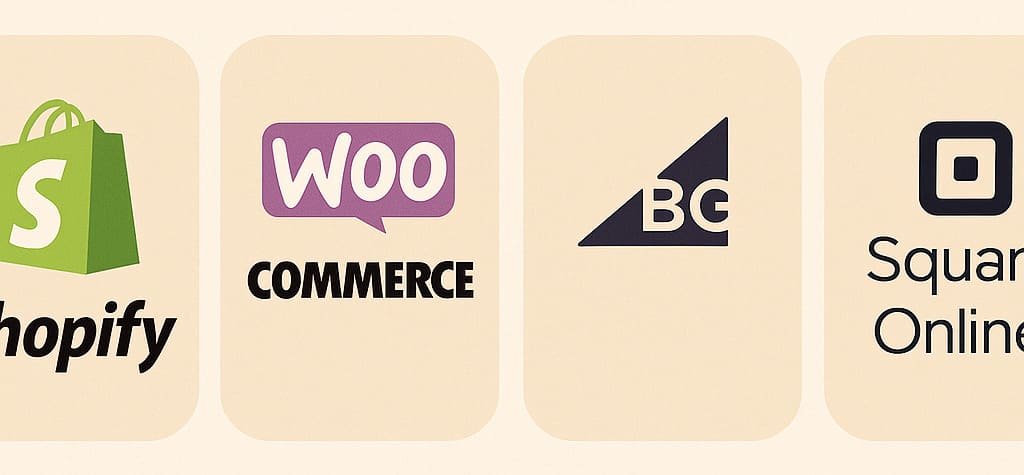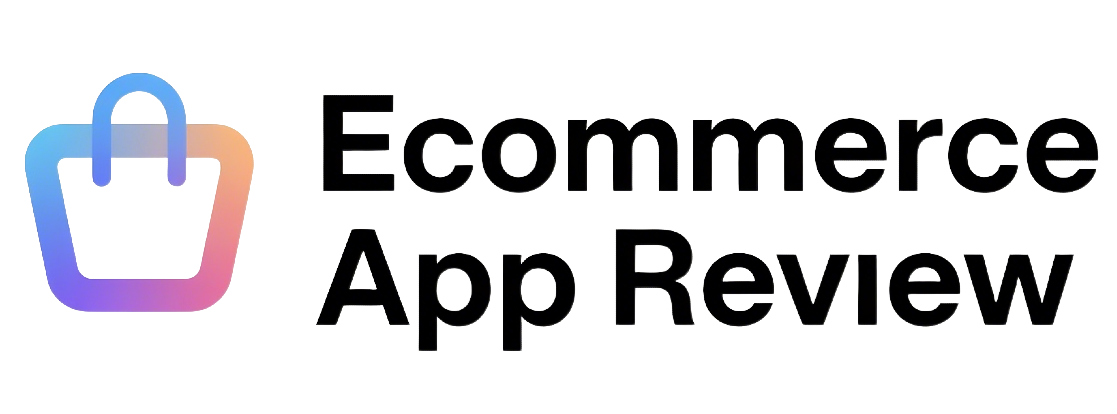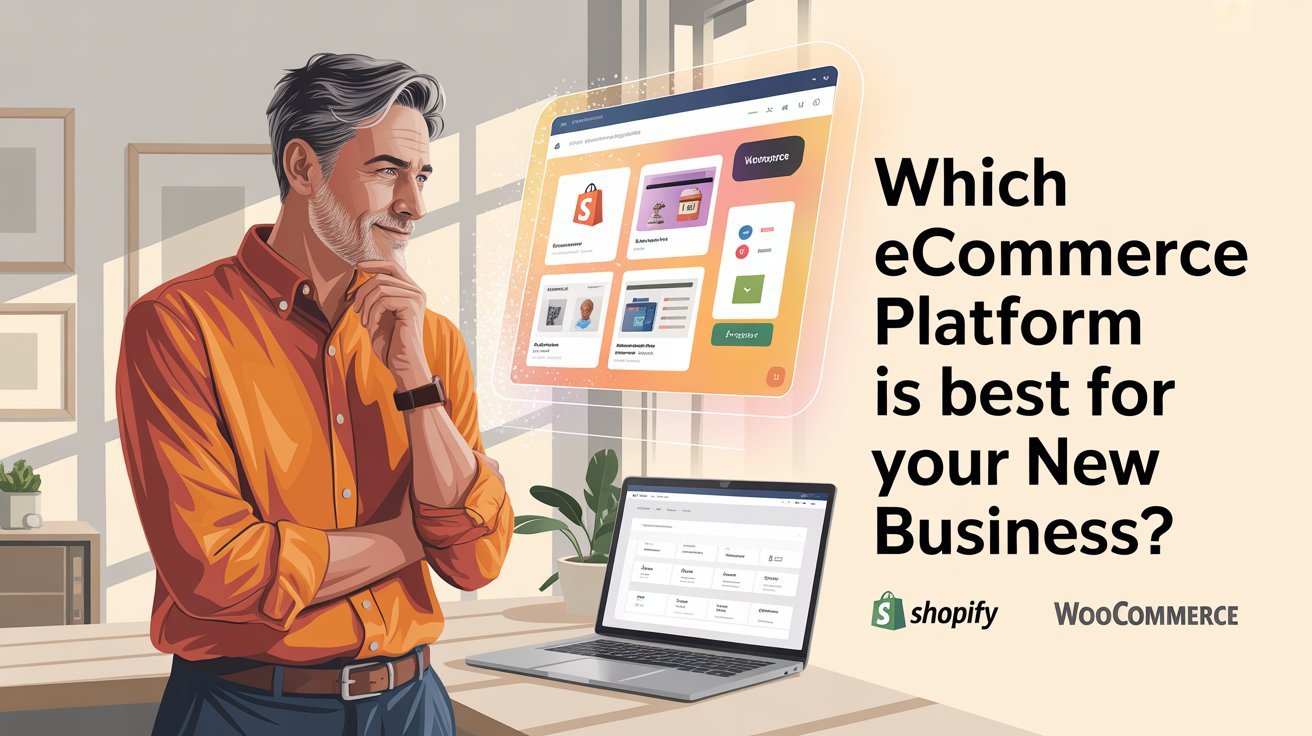You Don’t Need 6 Months and 52 Browser Tabs
Let’s be honest. picking an ecommerce platform shouldn’t feel like studying for the big bar exam. But for some reason, it does. You start Googling, and suddenly you’re drowning in feature charts, Reddit threads, and YouTube tutorials claiming this one’s faster or that one’s cheaper or that one’s just better overall. I’ve seen smart, scrappy founders lose entire months comparing ecommerce platforms instead of actually selling something. And after nearly two decades helping people cut through the clutter, I’ll tell you what I tell my clients. The right ecommerce platform depends entirely on where your business is today, not what some listicle says is “best” for 2023, 2024 or 2025.
Let’s start with Sarah’s story.
She did what every smart entrepreneur thinks they should do. Spreadsheets. YouTube tutorials. Reddit deep dives. Six months of research. And while she was still tweaking her platform comparison doc, her competitor launched on a Tuesday and made their first sale by Friday.
Ouch.
If you’re reading this, you might be halfway down that rabbit hole yourself. Let’s stop that now.
I’ve spent 18 years helping people get unstuck in exactly this situation. From $200-a-month side hustles to $2M-a-year DTC brands, the pattern is clear: the ones who win don’t spend forever deciding. They pick, launch, and learn.
And no, I’m not saying platform choice doesn’t matter. I’m saying you can figure it out in 5 minutes if you ask the right questions, and choose the right tools. That’s what we’ll do here.
The Problem With Every “Best Ecommerce Platform” Article Out There
You’ve seen them.
“Shopify for beginners.”
“WooCommerce for developers.”
“BigCommerce for serious stores.”
“Which ecommerce site is the best.”
It’s like reading a car review that says:
“Toyota Corolla: good for people who need a car. Lamborghini: fast.”
Thanks for nothing, generic blog post.
These articles treat every business like it’s the same. But a handmade jewellery business generating $30K a year isn’t the same as a fast-growing outdoor gear startup. And a digital product creator needs totally different tools from a local bakery.
Oh, and they rarely tell you what actually breaks your business:
- The total cost once you add apps and payment fees.
- The pain of migrating when you outgrow your first choice.
- The tech frustration that makes you want to throw your laptop into traffic.
Let’s stop the madness.
The Costs Nobody Talks About (Until It’s Too Late)
Take Shopify. $39/month sounds great, right? But let’s do the math:
| Need | Real-World Cost |
|---|---|
| Shopify Basic | $39/month |
| Klaviyo for email marketing | $29/month |
| Judge.me for product reviews | $15/month |
| Abandoned cart recovery | $20/month |
| Better analytics | $35/month |
| Total monthly spend | $138/month |
And that’s before you even make your first sale.
WooCommerce folks like to brag about it being “free.”
Ridiculously misleading.
Here’s the catch:
- Decent hosting: $120/month
- Security monitoring: $30/month
- Backups and maintenance: $20/month
- Developer on call when your plugin breaks: at least $500/month, unless you like late-night PHP debugging.
Oh, and then there’s migration hell.
Lisa from Denver started on Squarespace because it was simple and pretty. A year later she switched to Shopify and spent $6,000 on dev work and lost three weeks of sales. And approximately ten years of her life expectancy from stress.
The Ecommerce Platform Selection Framework That’ll Save You (And Your Sanity)
Forget endless feature lists. You only need to think about five things:
- Your business stage.
Side hustle? Full-time team? These two aren’t in the same universe. - Your technical comfort level.
If you don’t like tinkering, don’t pick a platform that needs tinkering. Obvious, but somehow ignored. - Your growth plan.
Be honest. Are you doubling revenue this year, or trying to validate your first product? - Your real budget.
Not just the subscription fee. Apps, transaction fees, your time, dev help, all of it. - The 3-4 features you truly need.
Not what sounds cool on a sales call. The stuff your business must have to sell effectively.
Take our 2-Minute Ecommerce Platform Quiz
Find the Right Ecommerce Platform for Where Your Business is at Right Now
If you’re anything like most entrepreneurs I work with, you want clear answers, fast.
That’s why we built this quick assessment.
No fluff, no generic recommendations. Just a few smart questions to help you figure out what ecommerce platform fits your business stage, technical comfort, and growth goals.
Answer honestly.
It’ll only take two minutes (actually, probably even less).
And you’ll get a real recommendation based on 18 years of helping brands launch, grow, and scale. Not what some comparison site with affiliate links wants you to buy.
What Works in the Real World (Not in Theory)
Let’s break it down by business type.
No fluff, no hypotheticals.
Just what works when the rubber hits the road.
1. The Side Hustler (< $15K/Year)
You’re testing the waters. Selling handmade stuff, dropshipping gadgets, or running print-on-demand tees. Revenue’s small but growing. It’s probably just you and your laptop — maybe your cat supervising.
Your priorities:
- Keep it cheap.
- Keep it simple.
- Don’t commit to a complex platform you might abandon in 6 months.
My pick: Start with Square Online or Ecwid.
Yep. Not Shopify. Not WooCommerce. You don’t need the heavy hitters yet.
Take Maria, for example. She started selling $12 handmade soaps from her Austin kitchen. Used Square’s free plan for eight months while figuring out if people actually wanted lavender-vanilla bars (they did). Total platform cost in Year 1? $72. That’s less than Shopify would have cost her in two months.
Bonus: When you’re ready to upgrade, migrating to Shopify or BigCommerce is a weekend project — not a 3-week nightmare.
2. The Established Small Business ($15K – $150K/Year)
Now we’re talking. You’ve got proof of demand. Maybe a team of 1–3 people. Brand is polished, customers expect a professional experience. DIY solutions are starting to crack under pressure.
Your priorities:
- Look pro.
- Streamline operations.
- Get access to useful apps without learning to code.
My pick: Shopify.
This is where Shopify really shines.
Take David, who runs an outdoor gear brand. At $67K/year, his old site looked like a Craigslist ad. After switching to Shopify, his conversion rate jumped 38%. Mostly because customers stopped abandoning carts at checkout at the clip he was experiencing before.
Shopify handles the boring but “tablestakes” stuff like security, hosting, and updates, so you can focus on selling and optimizing your store.
Real-world costs for David on Shopify:
- $39/month for Shopify Basic
- $89/month for essential apps (email, reviews, analytics)… we pulled most of his stack from this guide to the best Shopify apps for 2025.
- $280 one-time for a pro theme
- $19 annually for a branded domain
➤ All in: $151/month + transaction fees (which feel expensive until you factor in what you’d pay for the same infrastructure anywhere else), plus a bit of up-front investment in a great theme and domain.
When Shopify stops making sense:
- If you hit $400K+ annually and transaction fees start eating you alive and chipping away at your margins.
- Or when you need deep customizations that would cost a fortune on Shopify’s closed ecosystem.
3. The Growth Stage Brand ($150K – $750K/Year)
This is where things get dangerous, and expensive to screw up.
You’re scaling fast, hiring a team, maybe eyeing international sales.
Your priorities:
- Reduce transaction fees (they’ll kill your margins).
- Automate more of your operations.
- Plan for scale.
My pick: BigCommerce.
Jennifer’s fashion brand hit $480K in sales last year. Staying on Shopify would’ve cost her nearly $14K in annual transaction fees alone. Instead, she switched to BigCommerce, with no transaction fees and the $399/month Enterprise plan includes abandoned cart recovery, advanced SEO, and robust analytics — features Shopify makes you add via apps. If you’re staying on Shopify, you’ll want to explore some AI-powered apps that help level the playing field.
Tradeoffs:
- Steeper learning curve than Shopify.
- Smaller app ecosystem.
- Less intuitive for non-technical users.
Alternate pick: Shopify Plus, starting at $2,300/month. Great if you have dev resources and need Shopify’s polish but at enterprise scale. Overkill for most under $1.5M/year… and this is an important number to keep in mind, as over $2K/month in platform fees is a LOT to digest in the early going.
4. The Technical Business Owner
You like to tinker. Or maybe you have an in-house developer who gets twitchy without server access.
Your priorities:
- Flexibility.
- Long-term cost control.
- Custom integrations.
My pick: WooCommerce.
Marcus (different guy, same name) runs a B2B industrial supply biz. Their product pricing and ERP integrations are way too complex for Shopify or BigCommerce. WooCommerce let them build what they needed.
But here’s the catch… WooCommerce isn’t actually “free” when you think about the total cost of ownership and operating the site:
- $145/month for solid hosting.
- $400/year in premium plugins.
- 12 hours/month of dev time.
➤ Total monthly burn: ~$320 (plus quite a bit of labor).
That’s still cheaper than Shopify Plus, but way more work.
If you’re not technical, stay far away from WooCommerce. Unless, of course, you enjoy waking up at 2 a.m. because your checkout broke after a WordPress update – or you have a solid team of technical experts to support the back-end operations of the stack.
5. The Multi-Channel Retailer
You sell online, in-store, at pop-ups, on marketplaces — everywhere. Managing inventory across all those channels is a nightmare waiting to happen.
Your priorities:
- Unified inventory and sales tracking.
- Seamless POS and ecommerce integration.
- No overselling disasters.
My pick: Square.
Rachel runs three boutique stores in Austin plus an online shop. Square syncs her inventory in real-time across all locations. When someone buys the last size medium sweater online, it’s instantly marked out of stock in-store.
If your business lives both online and offline, Square’s simplicity is a gift.
Shopify POS works too, but it’s pricier and requires separate hardware. If you’re mostly online, Shopify’s POS is fine. But if you’re truly multi-channel, Square wins for simplicity and cost.
So, What Should You Do?
Coming up next: your 90-day implementation plan to stop overthinking and start selling.
Your 90-Day Ecommerce Platform Launch Plan (Stop Overthinking, Start Selling)
Most people spend six months stuck on the first week. Let’s break that bad habit.
Days 1 to 30: Lay the Groundwork
Week 1: Platform Setup
- Pick your platform. Done today.
- Connect your domain.
- Choose a basic theme. Stop hunting for the perfect design — you’ll change it later anyway.
Week 2: Build Your Product Catalog
- Add product photos, descriptions, and pricing.
- Keep it simple. No need to write the next great American novel in your product descriptions.
Week 3: Payments, Shipping, and Taxes
- Set up Stripe or Shopify Payments.
- Configure shipping zones and tax rates.
- Place a few test orders. (Pro tip: actually ship something to yourself. You’d be amazed how often people forget that part.)
Week 4: Final Testing + Team Training
- Run through every scenario: returns, refunds, weird order combos.
- If your team doesn’t know how to issue a refund, you’re not ready.
Days 31 to 60: Launch and Learn
Week 5-6: Add Essential Features
- Email automation (welcome emails, abandoned cart flows)
- Customer reviews
- Basic analytics tracking
- Abandoned cart recovery
- Not sure where to start? Here’s a curated list of Shopify apps to grow your store.
Week 7-8: Connect Marketing Channels
- Google Analytics, Facebook Pixel, TikTok, etc.
- Social media integrations
- Simple email capture (don’t overbuild your funnel yet)
Days 61 to 90: Optimize and Scale
Week 9-10: Optimize Performance
- Speed up your site.
- Improve product descriptions based on real customer questions.
- Start basic conversion rate tests.
Week 11-12: Prepare for Growth
- Document your processes.
- Train your team on returns, fulfillment, customer service.
- Build simple backup and recovery procedures.
Launch first, perfect later. Every week you delay is a week your competitors are stealing sales.
Common Mistakes That Kill Ecommerce Dreams
1. Skipping Mobile Optimization
If your checkout doesn’t work on a four-year-old Android phone, you’re losing sales. Test it yourself. On slow Wifi… and make sure you start with the mobile experience in mind.
2. Neglecting Payment Testing
Run every weird scenario: declined cards, international addresses, billing mismatches. Fix the weird bugs before your customers find them.
3. Messing Up Inventory Sync
Multi-channel sellers, this is for you. Overselling gets you banned from marketplaces. Underselling wastes inventory. Either way, you lose.
4. Ignoring Security Basics
SSL, backups, strong passwords, two-factor authentication. Skipping this stuff is like leaving your store’s front door open overnight.
5. Bad Product Photos
I don’t care how great your platform is — ugly photos kill conversions. Hire someone with a camera and basic lighting.
6. Perfection Paralysis
Stop waiting for perfect. Launch at 80%. You’ll learn more in your first week of real sales than in six months of planning.
How to Future-Proof Your Platform Choice
No one talks about this, but switching platforms is expensive. Plan for what’s next:
- Data Portability: Can you export your orders, customers, and products without paying a ransom?
- Customization Debt: The more you hack your platform, the harder it is to migrate later.
- Integration Complexity: The more tools your platform connects to, the bigger the hassle when you switch.
- Growth Trends: Look for platforms investing in things like headless commerce, AI personalization, and multi-channel selling.
But here’s the truth: successful businesses outgrow their platforms. And that’s a good thing.
Here’s What You Need to Do:
- Take the Assessment. I built it based on 18 years of helping brands like yours.
- Pick Your Platform. Stop hunting for a perfect choice. It doesn’t exist.
- Set a 30-Day Launch Deadline. Yes, really. 30 days.
- Launch Ugly. Optimize Later.
Your competitors are making sales while you’re still comparing platforms in your 47th browser tab. Stop waiting. Start building.

The Final Word
Which platform is best? The one you’ll actually launch on.
In six months, you won’t remember which feature tipped the scales. You’ll only remember whether you made your first sale.
Take the quiz. Pick your platform. Build something people will actually buy.
Your future self will thank you.


5 thoughts on “Which Ecommerce Platform is Best for Your New Business? [5-Minute Assessment + Quiz]”